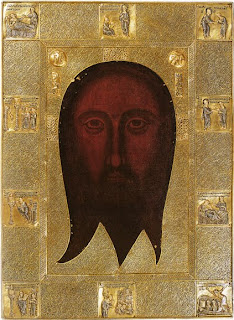Why is it important for those who believe in Jesus as the Messiah to at least see the physical features of him who taught them the path to God? For one, many think that Jesus is just a myth, a product of the fertile imagination of those who preached Christianity. Some say that there exist no "historical Jesus" and that the Jesus who probably lived was not the Jesus preached by the apostles, foremost of who was Paul whose teachings were contradictory to what the Gospels.
The earliest depictions of Christ can be seen in the catacombs, where early Christians drew their own interpretations of what Jesus looked like. There are two overwhelming themes in these catacombs: one, a bearded Jesus and the other, a young shepherd, without a beard. Jesus was believed to be a descendant of David, who was a shepherd before he was anointed by God to become King of the Israelites. This probably explains why some early believers depicted him as such.
Studies clearly show that Jesus was probably bearded, since this conforms with Jewish religious customs and as a teacher of the Law, surely, Jesus must have conformed with it. Based on the Book of Deuteronomy, those of the Levites, members of the priestly class, must have beards. Since Jesus himself said that he came to fulfill the law and not destroy it, surely he would have obeyed one of the most basic of all traditions and customs.
In several Hadiths in the Holy Qu'ran, Prophet Muhammad (PBUH) depicted Isa (the Islamic name of Jesus) as a man of average height, with a brown (or more accurately reddish) complexion, a beard and with shoulder-length hair. This description of Jesus conforms with early Christian paintings and those drawn in Christian catacombs.
Several traditions show Christ in most occasions either looking very serious or very morose, all extremes. Yet, modern depictions show Jesus looking very much human--sometimes smiling, sometimes serious or jovial and sometimes angry. Jesus, if you believe in him, lived like a human and as a human, he smiled, he frowned, he gets angry and he probably was very serious when he taught the Jews the laws of God.
He probably looked like what Jews in his age looked like--with a high nose, big round expressive eyes, curly hair and average beard length. His built was probably medium, since he lived as a carpenter just like his father John. And he, like the Jews, was probably of brown complexion since he spent most of his time in the desert.
The Roman Publius Lentullus, a Governor, wrote the following epistle to the Roman Senate concerning "Yeshua" a Nazarene, who lived in the days of Tiberius Caesar:Now, why did the early Christians not gave us the luxury of at least one picture of Jesus? The answer is simple--Jesus, the man, is not as important as his message. The tradition of having icons looking like him was of pagan origins, never a Christian tradition. Physical depictions of persons or personalities were violations of true Christian teachings which mandates the worship and devotion to God alone, Who Is the Purest of the Pure Spirit, hence, without any physical likeness. Those who truly believe in God worship Him in Spirit and in Truth.
"There appeared in these our days a man, of the Jewish Nation, of great virtue, named Yeshua [Jesus], who is yet living among us, and of the Gentiles is accepted for a Prophet of truth, but His own disciples call Him the Son of God- He raiseth the dead and cureth all manner of diseases. A man of stature somewhat tall, and comely, with very reverent countenance, such as the beholders may both love and fear, his hair of (the colour of) the chestnut, full ripe, plain to His ears, whence downwards it is more orient and curling and wavering about His shoulders. In the midst of His head is a seam or partition in His hair, after the manner of the Nazarenes. His forehead plain and very delicate; His face without spot or wrinkle, beautified with a lovely red; His nose and mouth so formed as nothing can be reprehended; His beard thickish, in colour like His hair, not very long, but forked; His look innocent and mature; His eyes grey, clear, and quick- In reproving hypocrisy He is terrible; in admonishing, courteous and fair spoken; pleasant in conversation, mixed with gravity. It cannot be remembered that any have seen Him Laugh, but many have seen Him Weep. In proportion of body, most excellent; His hands and arms delicate to behold. In speaking, very temperate, modest, and wise. A man, for His singular beauty, surpassing the children of men"The above description fits the Mandylion of Edessa, the earliest paintings ever rendered
This is another letter, written by Pontius Pilate himself to Tiberius Caesar. This has been retrieved from the Congressional Library in Washington D.C.
This is an early depiction of Jesus which was made by order of Pontius Pilate and given to Tiberius. This emerald was taken by the Emperor of the Turks before being given to Pope Innocent VIII as a ransom for the Emperor's brother who was taken captive during the crusades.
TO TIBERIUS CAESAR:
A young man appeared in Galilee preaching with humble unction, a new law in the Name of the God that had sent Him. At first I was apprehensive that His design was to stir up the people against the Romans, but my fears were soon dispelled. Jesus of Nazareth spoke rather as a friend of the Romans than of the Jews. One day I observed in the midst of a group of people a young man who was leaning against a tree, calmly addressing the multitude. I was told it was Jesus. This I could easily have suspected so great was the difference between Him and those who were listening to Him. His golden colored hair and beard gave to his appearance a celestial aspect. He appeared to be about 30 years of age. Never have I seen a sweeter or more serene countenance. What a contrast between Him and His bearers with their black beards and tawny complexions! Unwilling to interrupt Him by my presence, I continued my walk but signified to my secretary to join the group and listen. Later, my secretary reported that never had he seen in the works of all the philosophers anything that compared to the teachings of Jesus. He told me that Jesus was neither seditious nor rebellious, so we extended to Him our protection. He was at liberty to act, to speak, to assemble and to address the people. This unlimited freedom provoked the Jews -- not the poor but the rich and powerful.
Later, I wrote to Jesus requesting an interview with Him at the Praetorium. He came. When the Nazarene made His appearance I was having my morning walk and as I faced Him my feet seemed fastened with an iron hand to the marble pavement and I trembled in every limb as a guilty culprit, though he was calm. For some time I stood admiring this extraordinary Man. There was nothing in Him that was repelling, nor in His character, yet I felt awed in His presence. I told Him that there was a magnetic simplicity about Him and His personality that elevated Him far above the philosophers and teachers of His day.
Now, Noble Sovereign, these are the facts concerning Jesus of Nazareth and I have taken the time to write you in detail concerning these matters. I say that such a man who could convert water into wine, change death into life, disease into health; calm the stormy seas, is not guilty of any criminal offense and as others have said, we must agree -- truly this is the Son of God.
Your most obedient servant,
Pontius Pilate
Another description, this time taken in the Archko volumes, described Jesus as:
"I asked him to describe this person to me, so that I might know him if I should meet him. He said: 'If you ever meet him [Yeshua] you will know him. While he is nothing but a man, there is something about him that distinguishes him from every other man. He is the picture of his mother, only he has not her smooth, round face. His hair is a little more golden than hers, though it is as much from sunburn as anything else. He is tall, and his shoulders are a little drooped; his visage is thin and of a swarthy complexion, though this is from exposure. His eyes are large and a soft blue, and rather dull and heavy....' This Jew [Nazarite] is convinced that he is the Messiah of the world. ...this was the same person that was born of the virgin in Bethlehem some twenty-six years before..." - The Archko Volume, translated by Drs. McIntosh and Twyman of the Antiquarian Lodge, Genoa, Italy, from manuscripts in Constantinople and the records of the Senatorial Docket taken from the Vatican of Rome (1896) 92-93
Since early Christians were former pagans, worshippers of Zeus and Dionysius, some of them drew depictions of Jesus based on their preconceived beliefs in their former deities. That is why it is clearly non-Christian to even pray before idols and icons because it is a tradition which traces its roots not in Christianity but in paganism.






No comments:
Post a Comment
Thank you very much for reading my blog. You inspired me. But if you intend to put your name "anonymous", better not comment at all. Thanks!